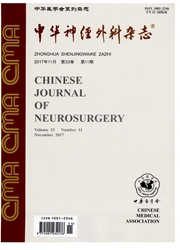

 中文摘要:
中文摘要:
目的探讨脑脊液降钙素原(PCT)在鉴别成人颅内细菌性感染与无菌性脑膜炎中的作用。方法回顾性分析2013年10月至2014年3月首都医科大学附属北京天坛医院神经外科脑肿瘤术后48~72h出现疑似细菌性颅内感染症状的患者178例。行脑脊液常规、生化及PCT的检测。按照颅内感染的诊断标准,将其分为细菌性感染组(50例)和无菌性脑膜炎组(128例)。比较两组脑脊液PCT及传统脑脊液检测指标的变化情况,应用受试者工作特征曲线(ROC)分析脑脊液PCT对鉴别感染及无菌性脑膜炎的价值。结果与无菌性脑膜炎组比较,细菌性感染组脑脊液中白细胞数量、多核细胞比例、蛋白质含量、PCT含量均增高,糖降低,差异均有统计学意义(均P〈0.01);氯化物差异无统计学意义。其中感染组脑脊液PCT中位数(范围)为0.15ng/ml(0—3.09ng/m1),无菌性脑膜炎组为0ng/ml(0—0.46ng/m1)。ROC结果显示,PCT鉴别诊断细菌性颅内感染曲线下面积为0.746,诊断阈值为0.075ng/ml,敏感性为68.0%,特异性为72.7%,阳性预测值为49.3%,阴性预测值85.3%。脑脊液PCT与白细胞、多核细胞比例、蛋白含量呈正相关(r分别为0.446、0.453、0.482,均P〈0.01;与糖呈负相关(r=-0.201,P=0.007)。结论脑脊液PCT检测对诊断神经外科术后细菌性颅内感染具有重要的临床应用价值。
 英文摘要:
英文摘要:
Objective To investigate the role of the cerebrospinal fluid procalcitonin (PCT) in the identification of intracranial bacterial infection and aseptic meningitis in adults. Methods A total of 178 patients with the suspected symptom of intracranial bacterial infection at 48 to 72 h after neurosurgical brain tumor surgery at the Department of Neurosurgery, Beijing Tiantan Hospital, Capital Medical University from October 2013 to March 2014 were analyzed retrospectively. The cerebrospinal fluid routine, biochemical and procalcitonin tests were performed. According to the diagnostic criteria of intracranial infection, they were divided into either a bacterial infection group ( n = 50) or an aseptic meningitis group ( n = 128 ). The cerebrospinal fluid PCT and its changes of the traditional cerebrospinal fluid detection index were compared. The receiver operating characteristic curve (ROC) was used to analyze the values of cerebrospinal fluid PCT for identifying the infection and aseptic meningitis. Results Compared with the aseptic meningitis group, the white blood cell count, polynuclear cell ratio, protein content, and PCT content were all increased in the cerebrospinal fluid of bacterial infection, and the blood glucose was reduced. There were significant differences (all P 〈 0. 01 ). There was no significant difference in chloride. The median (range) of cerebrospinal fluid PCT in the bacterial infection group was 0. 15 ng/ml ( 0 - 3.09 ng/ml), and in the aseptic meningitis group was 0 ng/ml (0 -0. 46 ng/ml). The ROC results showed that the area under curveof the differential diagnosis of intracranial bacterial infection was 0. 746. The diagnostic threshold was O. 075 ng/ml, the sensitivity was 68.0%, specificity was 72. 7%, positive predictive value was 49.3%, and negative predictive value was 85.3%. The PCT in cerebrospinal fluid was positively correlated with the leukocyte, proportion of multinucleated cells, and protein (r =0. 446, 0. 453, and 0. 482, respectively, all P 〈
 同期刊论文项目
同期刊论文项目
 同项目期刊论文
同项目期刊论文
 期刊信息
期刊信息
